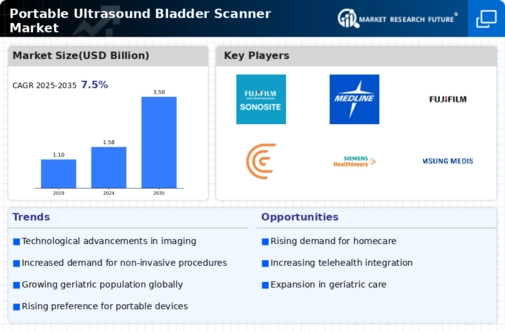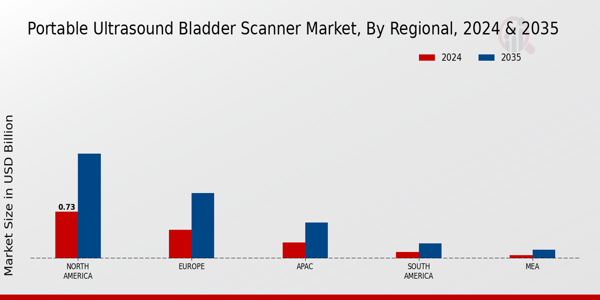Market Growth Projections
The Global Portable Ultrasound Bladder Scanner Market Industry is projected to experience substantial growth over the next decade. With a market value of 1.58 USD Billion in 2024, it is expected to reach 3.5 USD Billion by 2035, reflecting a compound annual growth rate of 7.5% from 2025 to 2035. This growth trajectory indicates a robust demand for portable ultrasound bladder scanners, driven by factors such as technological advancements, increasing prevalence of urinary disorders, and a shift towards home healthcare solutions. The market's expansion is indicative of the evolving landscape of diagnostic tools in the healthcare sector.
Shift Towards Home Healthcare Solutions
The Global Portable Ultrasound Bladder Scanner Market Industry is witnessing a shift towards home healthcare solutions, driven by the increasing preference for at-home medical care. Patients and healthcare providers are recognizing the benefits of portable ultrasound bladder scanners in home settings, where they can monitor bladder health without frequent hospital visits. This trend is particularly relevant for elderly patients and those with chronic conditions who require regular assessments. The convenience and accessibility of these devices are likely to enhance patient compliance and satisfaction, further propelling market growth in the coming years.
Increasing Prevalence of Urinary Disorders
The Global Portable Ultrasound Bladder Scanner Market Industry is influenced by the rising prevalence of urinary disorders, including urinary retention and incontinence. These conditions are becoming more common due to factors such as an aging population and lifestyle changes. As healthcare providers seek efficient methods for diagnosing and managing these disorders, portable ultrasound bladder scanners are gaining traction. Their ability to provide immediate feedback on bladder volume aids in timely interventions, thereby improving patient care. This growing need for effective diagnostic tools is likely to contribute to a compound annual growth rate of 7.5% from 2025 to 2035.
Rising Demand for Non-Invasive Diagnostics
The Global Portable Ultrasound Bladder Scanner Market Industry experiences an increasing demand for non-invasive diagnostic tools. Healthcare providers are increasingly adopting portable ultrasound bladder scanners due to their ability to provide quick and accurate assessments of bladder volume without the need for invasive procedures. This trend is particularly evident in outpatient settings and emergency departments, where rapid diagnosis is crucial. The convenience and efficiency of these devices contribute to their growing popularity, as they enhance patient comfort and reduce the risk of complications associated with invasive methods. As a result, the market is projected to reach 1.58 USD Billion in 2024.
Technological Advancements in Ultrasound Devices
Technological advancements play a pivotal role in the growth of the Global Portable Ultrasound Bladder Scanner Market Industry. Innovations such as improved imaging capabilities, enhanced portability, and user-friendly interfaces are driving the adoption of these devices. Manufacturers are increasingly integrating advanced features like real-time imaging and automated measurements, which improve diagnostic accuracy and efficiency. These enhancements not only facilitate better patient outcomes but also streamline workflow in clinical settings. As technology continues to evolve, the market is expected to expand significantly, with projections indicating a growth to 3.5 USD Billion by 2035.
Growing Awareness and Education on Bladder Health
The Global Portable Ultrasound Bladder Scanner Market Industry benefits from growing awareness and education regarding bladder health among both healthcare professionals and patients. Initiatives aimed at educating the public about urinary health issues and the importance of early diagnosis are fostering a more informed patient population. As awareness increases, the demand for effective diagnostic tools, such as portable ultrasound bladder scanners, is likely to rise. Healthcare providers are also becoming more knowledgeable about the advantages of these devices, which may lead to increased adoption in clinical practice.











